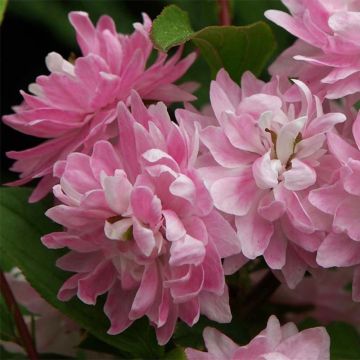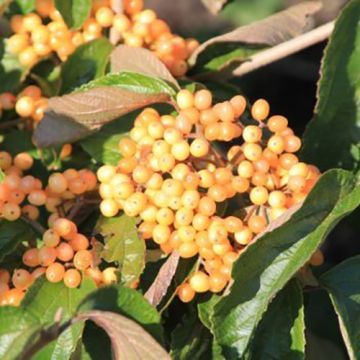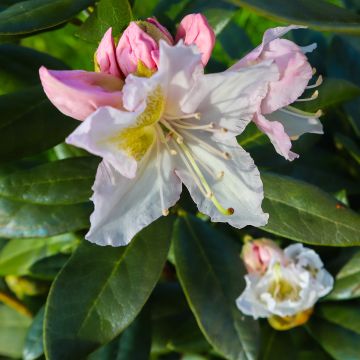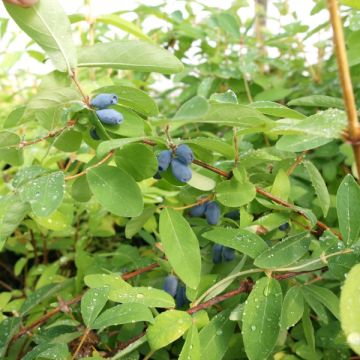

Prunus subhirtella Fukubana - Winter-flowering Cherry


Prunus subhirtella Fukubana - Winter-flowering Cherry


Prunus subhirtella Fukubana - Winter-flowering Cherry
Prunus subhirtella Fukubana - Winter-flowering Cherry
Prunus x subhirtella Fukubana
Winter-flowering Cherry, Higan Cherry, Spring Cherry, Rosebud Cherry
This item cannot be shipped to the selected country
Delivery charge from €5.90
Delivery charge from €5.90
Delivery to Corse prohibited
More information
Schedule delivery date,
and select date in basket
This plant carries a 24 months recovery warranty
More information
We guarantee the quality of our plants for a full growing cycle, and will replace at our expense any plant that fails to recover under normal climatic and planting conditions.
From €5.90 for pickup delivery and €6.90 for home delivery
Express home delivery from €8.90.
From €5.90 for pickup delivery and €6.90 for home delivery
Express home delivery from €8.90.
Delivery to Corse prohibited: UE law prohibits the import of this plant from mainland France to Corse as part of the fight against Xylella fastidiosa. Please accept our sincere apologies.
More information

Does this plant fit my garden?
Set up your Plantfit profile →
Description
Prunus x subhirtella 'Fukubana' is a variety of Japanese flowering cherry tree that is cloaked in an intense pink flowering, undoubtedly the brightest pink observed in these small trees. The other assets of this variety are a beautiful upright and bushy habit and beautiful yellow to red colours in autumn. Hardy and not very demanding in terms of soil, it combines charm, brilliance and robustness. So many good reasons to adopt it, even in a small garden.
Prunus x subhirtella 'Fukubana', belongs to the large Rosaceae family. It was introduced in Europe in 1927. It is commonly accepted nowadays that Prunus x subhirtella is a spontaneous hybrid originating from East Asia. 'Fukubana' stands out for its abundant spring flowering and remarkably bright pink colour. It is a deciduous tree with moderate development and moderately fast growth, reaching an average height of 3 m to 4 m (9.8 ft to 13.1 ft) with a spread of 2 m to 3 m (6.6 ft to 9.8 ft). It develops one or several short trunks and an upright and ovate crown. Flowering takes place in March-April depending on the region. The semi-double flowers are gathered in small clusters, suspended by a short peduncle. They emerge from dark carmine pink buds and then open into corollas with 12-14 toothed petals, resembling 3 cm (1.2 in) diameter pompoms. The flowers are followed by the formation of small black-purple fruits at maturity. The deciduous foliage is composed of alternate, ovate leaves, 3 cm to 8 cm (1.2 in to 3.1 in) long and 2 cm (0.8 in) wide, and coarsely toothed at the edges. The lamina, of a bright green colour, shows a pubescent underside and turns yellow, orange, and red in autumn. The bark is grey-brown and the young branches are pubescent.
Its twisted line drawn by sinuous branches makes the flowering cherry tree suitable for bonsai cultivation. 'Fukubana' shines from the first beautiful days of spring. WIth its modest stature and undemanding nature, it is suitable for small gardens as a standalone specimen or in the centre of a perennial bed whose flowering will take over from spring to summer. It can also be planted as a free hedge. Perfectly hardy, it can be grown in many regions, but dislikes compact and clayey soils or excessively dry situations. It can be planted with other spring-flowering shrubs, either simultaneously or staggered, such as forsythias, Japanese quinces, Honeysuckle (Lonicera xylosteum), flowering crab apples, flowering peaches, Chinese almond, hawthorns, and Japanese apricot (Prunus mume). A carpet of blue hyacinths, liverworts or blue grape hyacinths would be a beautiful addition at its base.
Report an error about the product description
Prunus subhirtella Fukubana - Winter-flowering Cherry in pictures




Plant habit
Flowering
Foliage
Botanical data
Prunus
x subhirtella
Fukubana
Rosaceae
Winter-flowering Cherry, Higan Cherry, Spring Cherry, Rosebud Cherry
Cultivar or hybrid
Other Prunus
Planting and care
Prunus x subhirtella 'Fukubana' thrives in full sun or partial shade in any fairly deep, moist but well-drained soil, preferably neutral to slightly alkaline, and neither excessively wet nor excessively dry. Water only during abnormally dry and hot weather. When planting, mix your soil with compost at a ratio of 50%. Dig a large planting hole. Apply a flowering shrub fertiliser every spring. Place the prunus in a sheltered spot from dry and cold winds, to enjoy its early flowering.
Planting period
Intended location
Care
-
, onOrder confirmed
Reply from on Promesse de fleurs
Spring-flowering shrubs
Haven't found what you were looking for?
Hardiness is the lowest winter temperature a plant can endure without suffering serious damage or even dying. However, hardiness is affected by location (a sheltered area, such as a patio), protection (winter cover) and soil type (hardiness is improved by well-drained soil).

Photo Sharing Terms & Conditions
In order to encourage gardeners to interact and share their experiences, Promesse de fleurs offers various media enabling content to be uploaded onto its Site - in particular via the ‘Photo sharing’ module.
The User agrees to refrain from:
- Posting any content that is illegal, prejudicial, insulting, racist, inciteful to hatred, revisionist, contrary to public decency, that infringes on privacy or on the privacy rights of third parties, in particular the publicity rights of persons and goods, intellectual property rights, or the right to privacy.
- Submitting content on behalf of a third party;
- Impersonate the identity of a third party and/or publish any personal information about a third party;
In general, the User undertakes to refrain from any unethical behaviour.
All Content (in particular text, comments, files, images, photos, videos, creative works, etc.), which may be subject to property or intellectual property rights, image or other private rights, shall remain the property of the User, subject to the limited rights granted by the terms of the licence granted by Promesse de fleurs as stated below. Users are at liberty to publish or not to publish such Content on the Site, notably via the ‘Photo Sharing’ facility, and accept that this Content shall be made public and freely accessible, notably on the Internet.
Users further acknowledge, undertake to have ,and guarantee that they hold all necessary rights and permissions to publish such material on the Site, in particular with regard to the legislation in force pertaining to any privacy, property, intellectual property, image, or contractual rights, or rights of any other nature. By publishing such Content on the Site, Users acknowledge accepting full liability as publishers of the Content within the meaning of the law, and grant Promesse de fleurs, free of charge, an inclusive, worldwide licence for the said Content for the entire duration of its publication, including all reproduction, representation, up/downloading, displaying, performing, transmission, and storage rights.
Users also grant permission for their name to be linked to the Content and accept that this link may not always be made available.
By engaging in posting material, Users consent to their Content becoming automatically accessible on the Internet, in particular on other sites and/or blogs and/or web pages of the Promesse de fleurs site, including in particular social pages and the Promesse de fleurs catalogue.
Users may secure the removal of entrusted content free of charge by issuing a simple request via our contact form.
The flowering period indicated on our website applies to countries and regions located in USDA zone 8 (France, the United Kingdom, Ireland, the Netherlands, etc.)
It will vary according to where you live:
- In zones 9 to 10 (Italy, Spain, Greece, etc.), flowering will occur about 2 to 4 weeks earlier.
- In zones 6 to 7 (Germany, Poland, Slovenia, and lower mountainous regions), flowering will be delayed by 2 to 3 weeks.
- In zone 5 (Central Europe, Scandinavia), blooming will be delayed by 3 to 5 weeks.
In temperate climates, pruning of spring-flowering shrubs (forsythia, spireas, etc.) should be done just after flowering.
Pruning of summer-flowering shrubs (Indian Lilac, Perovskia, etc.) can be done in winter or spring.
In cold regions as well as with frost-sensitive plants, avoid pruning too early when severe frosts may still occur.
The planting period indicated on our website applies to countries and regions located in USDA zone 8 (France, United Kingdom, Ireland, Netherlands).
It will vary according to where you live:
- In Mediterranean zones (Marseille, Madrid, Milan, etc.), autumn and winter are the best planting periods.
- In continental zones (Strasbourg, Munich, Vienna, etc.), delay planting by 2 to 3 weeks in spring and bring it forward by 2 to 4 weeks in autumn.
- In mountainous regions (the Alps, Pyrenees, Carpathians, etc.), it is best to plant in late spring (May-June) or late summer (August-September).
The harvesting period indicated on our website applies to countries and regions in USDA zone 8 (France, England, Ireland, the Netherlands).
In colder areas (Scandinavia, Poland, Austria...) fruit and vegetable harvests are likely to be delayed by 3-4 weeks.
In warmer areas (Italy, Spain, Greece, etc.), harvesting will probably take place earlier, depending on weather conditions.
The sowing periods indicated on our website apply to countries and regions within USDA Zone 8 (France, UK, Ireland, Netherlands).
In colder areas (Scandinavia, Poland, Austria...), delay any outdoor sowing by 3-4 weeks, or sow under glass.
In warmer climes (Italy, Spain, Greece, etc.), bring outdoor sowing forward by a few weeks.























































